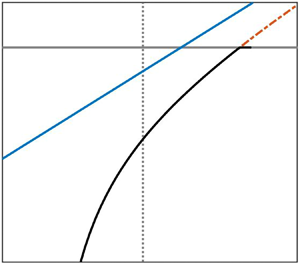Article contents
Bounds on heat transport for convection driven by internal heating
Published online by Cambridge University Press: 26 May 2021
Abstract

The mean vertical convective heat transport  $\langle wT \rangle$ between isothermal plates driven by uniform internal heating is investigated by means of rigorous bounds. These are obtained as a function of the Rayleigh number R by constructing feasible solutions to a convex variational problem, derived using a formulation of the classical background method in terms of a quadratic auxiliary function. When the fluid's temperature relative to the boundaries is allowed to be positive or negative, numerical solution of the variational problem shows that best previous bound
$\langle wT \rangle$ between isothermal plates driven by uniform internal heating is investigated by means of rigorous bounds. These are obtained as a function of the Rayleigh number R by constructing feasible solutions to a convex variational problem, derived using a formulation of the classical background method in terms of a quadratic auxiliary function. When the fluid's temperature relative to the boundaries is allowed to be positive or negative, numerical solution of the variational problem shows that best previous bound  $\langle wT \rangle \leqslant 1/2$ (Goluskin & Spiegel, Phys. Lett. A, vol. 377, issue 1–2, 2012, pp. 83–92) can only be improved up to finite R. Indeed, we demonstrate analytically that
$\langle wT \rangle \leqslant 1/2$ (Goluskin & Spiegel, Phys. Lett. A, vol. 377, issue 1–2, 2012, pp. 83–92) can only be improved up to finite R. Indeed, we demonstrate analytically that  $\langle wT \rangle \leqslant 2^{-21/5} {\textit {R}}^{1/5}$ and therefore prove that
$\langle wT \rangle \leqslant 2^{-21/5} {\textit {R}}^{1/5}$ and therefore prove that  $\langle wT\rangle < 1/2$ for
$\langle wT\rangle < 1/2$ for  ${\textit {R}} < 65\,536$. However, if the minimum principle for temperature is invoked, which asserts that internal temperature is at least as large as the temperature of the isothermal boundaries, then numerically optimised bounds are strictly smaller than
${\textit {R}} < 65\,536$. However, if the minimum principle for temperature is invoked, which asserts that internal temperature is at least as large as the temperature of the isothermal boundaries, then numerically optimised bounds are strictly smaller than  $1/2$ until at least
$1/2$ until at least  ${\textit {R}}=3.4\times 10^{5}$. While the computational results suggest that the best bound on
${\textit {R}}=3.4\times 10^{5}$. While the computational results suggest that the best bound on  $\langle wT\rangle$ approaches
$\langle wT\rangle$ approaches  $1/2$ asymptotically from below as
$1/2$ asymptotically from below as  ${\textit {R}}\rightarrow \infty$, we prove that typical analytical constructions cannot be used to prove this conjecture.
${\textit {R}}\rightarrow \infty$, we prove that typical analytical constructions cannot be used to prove this conjecture.
JFM classification
Information
- Type
- JFM Papers
- Information
- Copyright
- © The Author(s), 2021. Published by Cambridge University Press
References
REFERENCES
- 18
- Cited by


